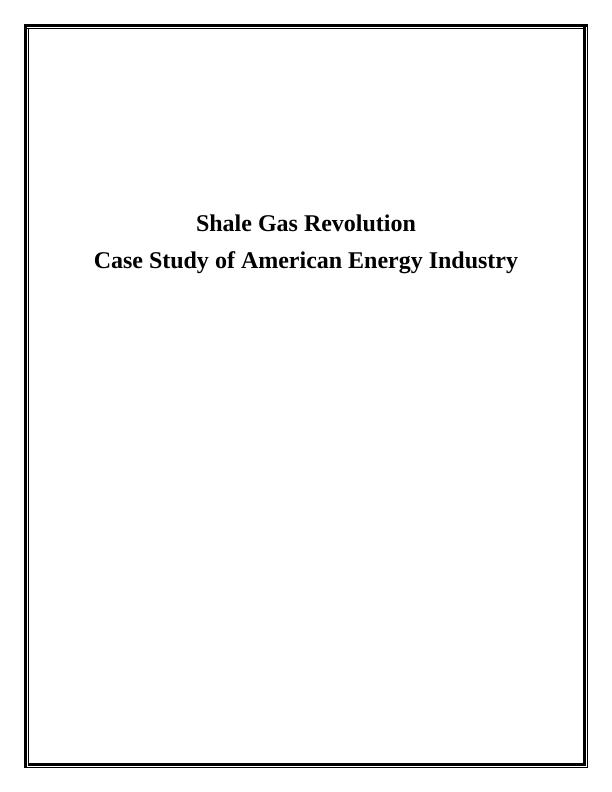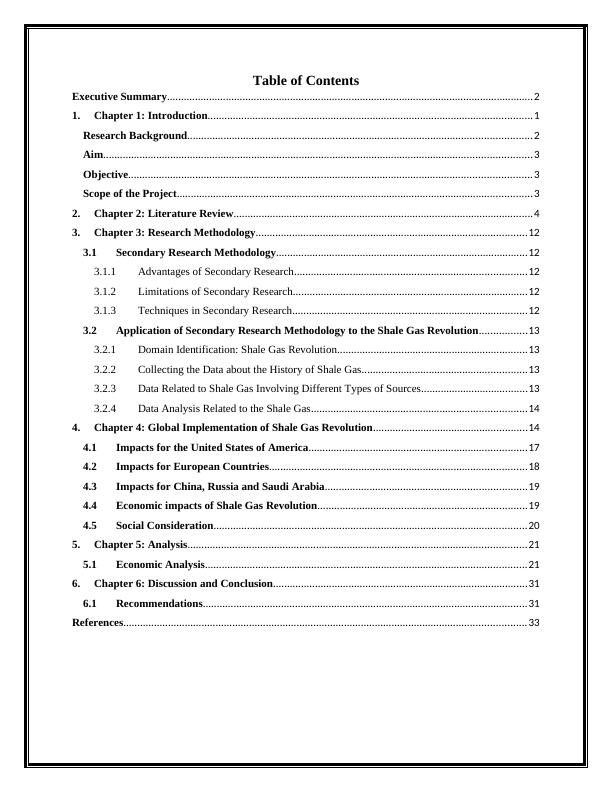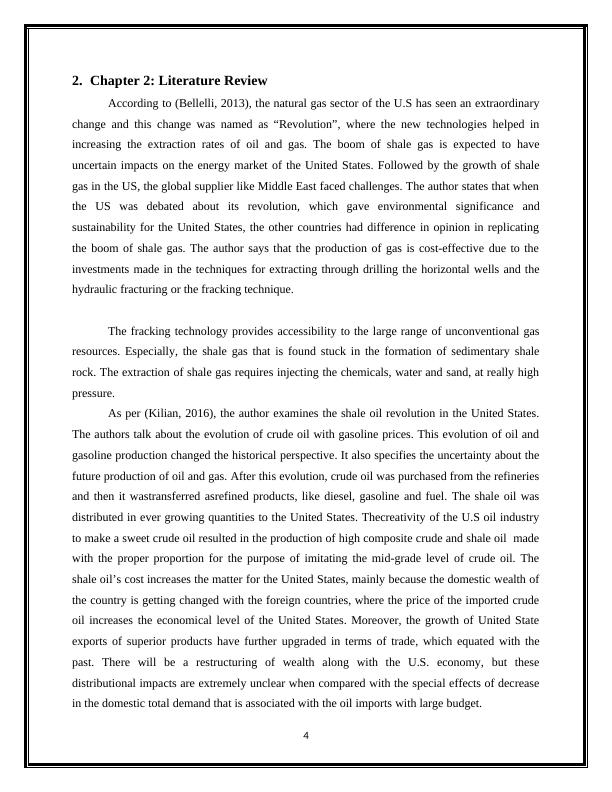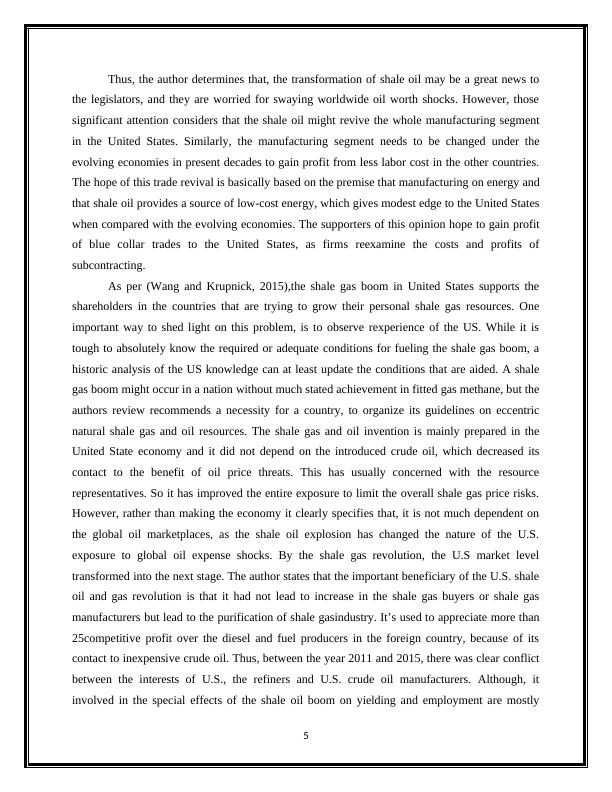The Shale Gas Revolution Case Study of American Energy Industry Executive Summary
38 Pages12803 Words335 Views
Added on 2020-02-24
About This Document
Chapter 3: Research Methodology 12 4.1 Secondary Research Methodology 12 3.1.1 Advantages of Secondary Research 12 3.1.2 Limitations of Secondary Research 12 3.1.3 Techniques in Secondary Research 12 4.2 Introduction of Secondary Research Methodology to the Shale Gas Revolution 13 3.2.1 Domain Identification: Shale Gas Revolution 13 denotes the global supply of shale gas 13 3.2.2 Collecting the Data about the History of Shale Gas 13 3.2.3 Data Related to Shale Gas Involving Different Types of Sources 13 3.2.4 Data Analysis
The Shale Gas Revolution Case Study of American Energy Industry Executive Summary
Added on 2020-02-24
ShareRelated Documents
Shale Gas RevolutionCase Study of American Energy Industry

Executive SummaryThe Shale Gas Revolution is considered as a mix of hydraulic fracturing and horizontal drilling.This process made the USA to be capable of extensively increase its production of oil and naturalgas. Today, the USA is the leading producer of dry natural gas in the whole world. It generates20 percentage of the global supply and 40 percentages from the shale. Increase in this productionleads the U.S to decline the import of net petroleum, ranging 27 percentage of the totalconsumption of the US. The extraordinary change in the production of oil and gas, wasconsidered as a “Revolution” in the US. The country faced increased employment opportunityfrom 2010 to 2012, from the oil and gas industry. It is observed that the production of oil and gasin the United States has diversified the global supply. The other observation is projected on theassociation of the U.S with the global market, which affects the price of the oil.US can besuccessful with its unique regulations on the rights of the resource land, but the difference in thegeological and political situation demands exceptional approach, to develop the shale resourcesin other countries. Thus, the Middle East’s supply interruption could be the reason for hurting theUS consumers and increased challenges. Thus, this project deals with the case study of Shale gasrevolution in the US. The growth of shale gas paved the way for uncertain effects on the U.Senergy market, and these impacts lead to perform various researches to analyze Shale gasrevolution. In the US, the reduction of carbon dioxide emission and greenhouse gas pollution isnoticed due to shale gas. There is argument related to shale gas that, it has some impact on theU.S government. The shale gas in the U.S is five times inexpensive when compared to theconventional European gas, which impacts the energy market of the United States.

Table of ContentsExecutive Summary...................................................................................................................................21.Chapter 1: Introduction....................................................................................................................1Research Background...........................................................................................................................2Aim.........................................................................................................................................................3Objective................................................................................................................................................3Scope of the Project...............................................................................................................................32.Chapter 2: Literature Review...........................................................................................................43.Chapter 3: Research Methodology.................................................................................................123.1Secondary Research Methodology..........................................................................................123.1.1Advantages of Secondary Research...................................................................................123.1.2Limitations of Secondary Research....................................................................................123.1.3Techniques in Secondary Research....................................................................................123.2Application of Secondary Research Methodology to the Shale Gas Revolution.................133.2.1Domain Identification: Shale Gas Revolution....................................................................133.2.2Collecting the Data about the History of Shale Gas...........................................................133.2.3Data Related to Shale Gas Involving Different Types of Sources......................................133.2.4Data Analysis Related to the Shale Gas.............................................................................144.Chapter 4: Global Implementation of Shale Gas Revolution.......................................................144.1Impacts for the United States of America..............................................................................174.2Impacts for European Countries............................................................................................184.3Impacts for China, Russia and Saudi Arabia........................................................................194.4Economic impacts of Shale Gas Revolution...........................................................................194.5Social Consideration................................................................................................................205.Chapter 5: Analysis.........................................................................................................................215.1Economic Analysis...................................................................................................................216.Chapter 6: Discussion and Conclusion...........................................................................................316.1Recommendations....................................................................................................................31References................................................................................................................................................33

1.Chapter 1: Introduction Shale Gas Revolution denotes the blend of both hydraulic fracturing and horizontaldrilling, which made the USA capable of increasing its oil and natural gas production.Especially, from the formation of tight oil which accounts 36 percentage of overall production ofcrude oil in the USA (The Strauss Center, 2017) at present. American natural gas supplies wereonly 1% during 2000, but at present it has increased to 30% (Brooks, 2017). The capacity ofproducing oil in USA has decreased its reliance on the overseas’ oil imports. On the other hand itallows a significant boost to the country in terms of economy, and has been helpful in recoveringfrom the 2008 recession. The reports state that, the GDP of 2011 for the USA displayed morethan 1.5 percentage of oil and gas and is consistently increasing. This increase in oil and gas ledto employment in the USA during 2010 to 2012, because the oil and gas industry additionallyrequired nearly 169, 0000 people to work for them. It was observed that the new productionmade the USA one of the player in producing oil and gas. Earlier Middle East was the leadingproducer and supplier in the world, but the USA’s production has diversified the global supply.The domestic production of oil and gas is satisfying the consumption of the people in USA. Thefact noticed from the new production is that, the reduction in imports of hydrocarbonsimprovises the trade balance of the USA and it decreases the direct financial help to export oil, asit can counteract to the interests of the USA (The Strauss Center, 2017).The research determines the USA as the leading producer of dry natural gas in the world,with 20 percentage of the global supply and 40 percentage from the shale. Whereas, the increasein the production of domestic oil has reduced the imports of net petroleum to twenty sevenpercentage of total consumption of the US. The political figures consider that the boom of shalecan help in nurturing the U.S. with energy independence. But, the point is till the United Statesof America is associated with the global market, it is prone to price shocks, because the price ofoil is decided in the global market. However, though the USA proceeds with the shortening ofpetroleum with zero, the global price of oil would increase due to the Middle East’s supplyinterruption. This would ultimately hurt the consumers of the United States and thus, marketingthe natural gas is incoherent, which leads to various challenges (The Strauss Center, 2017).In the U.S, the advanced shale oil and gas contains various reason to be taken off. Exceptthe United States, the other countries surrendered their subsurface mineral rights to thegovernment. But, in US the land owner has the right to own the hydrocarbon resources. The1

improvisation of oil and gas in the US is the result of the country’s regulations, as it gives thestability and acceptable permitting process. Hence, the united States have various advantagesbecause of the big infrastructure network that can manage the growth of the oil and gas sector.However, success is possible for the U.S from these advantage, but the difference in the newgeological and political situation can demand exceptional method for developing the shaleresources in other parts of the globe (The Strauss Center, 2017).Research BackgroundThe extraordinary change in the production of oil and gas, was considered as a“Revolution” in the US. The country like the United States of America is known as a blessedcountry, but it is no longer the same. The reason is that, the USA is diversified, and it impacts onthis significant blessing of the country (Brooks, 2017). The unconventional gas and theunconventional oil has drastically transformed these jargons to shale gas and shale oil. Earlier,certain places of United States of America never generated much oil or gas, which they actuallyproduce now. For instance, North Dakota and Pennsylvania is considered as the best example toshow its drastic improvement in production of oil and gas. The shale gas’s boom providedunexpected impacts on the energy market of the U.S. These impacts caused to conduct variousresearch for analyzing the Shale gas revolution, and the difference of opinion was observed fromeach reports. Similarly, the report of 2010 raised two important questions such as will therevolution continue further and can it impact in other countries. The answers for these questionsin various reports were uncertain. This uncertainty increased and caused detrainment in theinvestment of conventional and unconventional gas. It is observed that various reports haveargued on the increasing demand of gas, which can cause gas shortage in the next decade, thatlead to the increase in the suppliers of such gas. This lead to the threat of uncertainty forinhibiting the investment in the renewable energy, in the countries which expect that generousvolume of cheap gas should exist for providing inexpensive route for the lower carbon economy,instead of renewables that costs high. This report created significant division between the shalegas’s proponents and opponents. On the other hand, it lead to battle between various analysts andauthors to determine the uncertainty of the realistic prospects for shale gas. Thus, it became veryimportant to generate an original report, which focuses on various developments to emphasize onthese uncertainties. The shale gas in the U.S is five times inexpensive when compare to the2

conventional European gas. This shook the energy market, because of its evident impact on theU.S.Therefore, this project report aims to run through all the aspects of Shale Gas Revolution,right from when it started to the present day. This research projects on what happened since thenand how it could change the present day impacts.AimThe aim of this study is to study about the Shale gas revolution.ObjectiveThe objective of this report is to provide the following:1)To determine the whether it is a revolution.2)To analyze its impacts in USA and in various other countries.3)To understand the general effects of Shale gas revolution.4)To determine the uncertainty on the continuation of this revolution and its impactin other countries.Scope of the ProjectThe research is based on the secondary research analysis. 3

2.Chapter 2: Literature Review According to (Bellelli, 2013), the natural gas sector of the U.S has seen an extraordinarychange and this change was named as “Revolution”, where the new technologies helped inincreasing the extraction rates of oil and gas. The boom of shale gas is expected to haveuncertain impacts on the energy market of the United States. Followed by the growth of shalegas in the US, the global supplier like Middle East faced challenges. The author states that whenthe US was debated about its revolution, which gave environmental significance andsustainability for the United States, the other countries had difference in opinion in replicatingthe boom of shale gas. The author says that the production of gas is cost-effective due to theinvestments made in the techniques for extracting through drilling the horizontal wells and thehydraulic fracturing or the fracking technique. The fracking technology provides accessibility to the large range of unconventional gasresources. Especially, the shale gas that is found stuck in the formation of sedimentary shalerock. The extraction of shale gas requires injecting the chemicals, water and sand, at really highpressure.As per (Kilian, 2016), the author examines the shale oil revolution in the United States.The authors talk about the evolution of crude oil with gasoline prices. This evolution of oil andgasoline production changed the historical perspective. It also specifies the uncertainty about thefuture production of oil and gas. After this evolution, crude oil was purchased from the refineriesand then it wastransferred asrefined products, like diesel, gasoline and fuel. The shale oil wasdistributed in ever growing quantities to the United States. Thecreativity of the U.S oil industryto make a sweet crude oil resulted in the production of high composite crude and shale oil madewith the proper proportion for the purpose of imitating the mid-grade level of crude oil. Theshale oil’s cost increases the matter for the United States, mainly because the domestic wealth ofthe country is getting changed with the foreign countries, where the price of the imported crudeoil increases the economical level of the United States. Moreover, the growth of United Stateexports of superior products have further upgraded in terms of trade, which equated with thepast. There will be a restructuring of wealth along with the U.S. economy, but thesedistributional impacts are extremely unclear when compared with the special effects of decreasein the domestic total demand that is associated with the oil imports with large budget. 4

Thus, the author determines that, the transformation of shale oil may be a great news tothe legislators, and they are worried for swaying worldwide oil worth shocks. However, thosesignificant attention considers that the shale oil might revive the whole manufacturing segmentin the United States. Similarly, the manufacturing segment needs to be changed under theevolving economies in present decades to gain profit from less labor cost in the other countries.The hope of this trade revival is basically based on the premise that manufacturing on energy andthat shale oil provides a source of low-cost energy, which gives modest edge to the United Stateswhen compared with the evolving economies. The supporters of this opinion hope to gain profitof blue collar trades to the United States, as firms reexamine the costs and profits ofsubcontracting.As per (Wang and Krupnick, 2015),the shale gas boom in United States supports theshareholders in the countries that are trying to grow their personal shale gas resources. Oneimportant way to shed light on this problem, is to observe rexperience of the US. While it istough to absolutely know the required or adequate conditions for fueling the shale gas boom, ahistoric analysis of the US knowledge can at least update the conditions that are aided. A shalegas boom might occur in a nation without much stated achievement in fitted gas methane, but theauthors review recommends a necessity for a country, to organize its guidelines on eccentricnatural shale gas and oil resources. The shale gas and oil invention is mainly prepared in theUnited State economy and it did not depend on the introduced crude oil, which decreased itscontact to the benefit of oil price threats. This has usually concerned with the resourcerepresentatives. So it has improved the entire exposure to limit the overall shale gas price risks.However, rather than making the economy it clearly specifies that, it is not much dependent onthe global oil marketplaces, as the shale oil explosion has changed the nature of the U.S.exposure to global oil expense shocks. By the shale gas revolution, the U.S market leveltransformed into the next stage. The author states that the important beneficiary of the U.S. shaleoil and gas revolution is that it had not lead to increase in the shale gas buyers or shale gasmanufacturers but lead to the purification of shale gasindustry. It’s used to appreciate more than25competitive profit over the diesel and fuel producers in the foreign country, because of itscontact to inexpensive crude oil. Thus, between the year 2011 and 2015, there was clear conflictbetween the interests of U.S., the refiners and U.S. crude oil manufacturers. Although, itinvolved in the special effects of the shale oil boom on yielding and employment are mostly5

End of preview
Want to access all the pages? Upload your documents or become a member.
Related Documents
OIL AND GAS MANAGEMENT 1 OIL AND GAS REVOLUTION IN THE UNITED STATES OF AMERICAlg...
|74
|15681
|435
Impact of Supply of Natural Gas on the Adoption of Renewable Energy in the UKlg...
|37
|13276
|91
Logistics and Supply Chain Management of Petroleumlg...
|48
|16570
|20
Impact of Renewable Energy on International Trade of Oil and Gaslg...
|38
|16309
|309
Impact of Oil Price Fluctuation on Transportation Industry in USAlg...
|27
|6775
|63
Impact of BREXIT on UK Oil and Natural Gas Companieslg...
|17
|3415
|403
